| Listing 1 - 10 of 10 |
Sort by
|
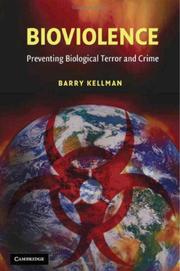
ISBN: 9780521883252 0521883253 9780521709699 0521709695 9780511510625 9780511342691 0511342691 1107185815 1281085278 9786611085278 1139133519 0511342160 0511341636 0511341059 0511510624 Year: 2007 Publisher: New York : Cambridge University Press,
Abstract | Keywords | Export | Availability | Bookmark
 Loading...
Loading...Choose an application
- Reference Manager
- EndNote
- RefWorks (Direct export to RefWorks)
Bioviolence is the hostile infliction of disease: our most fundamental terror. Traitors to humanity could inflict vast tolls making everyone potentially vulnerable. Bioviolence is the most realistic way for humanity's traitors to raze the pillars of modern civilization. Too little is being done to prevent bioviolence. While bio-offenders are becoming more focused and organized, prevention policies are vague, gap-ridden, and unsupervised. No other threat presents such severe danger yet such a failure of leadership to reduce risks. The strategy for preventing bioviolence requires a broad international commitment to promote bioscience while understanding its inherent and unavoidable dangers. Bioviolence threats shrink our planet into an interdependent neighborhood. This book explores how global governance should evolve to address challenges of advancing science and technology.
Bioterrorism --- Bioterrorism. --- Biomedical Research. --- International Cooperation. --- Public Health. --- Public Policy. --- Prevention. --- prevention & control. --- legislation & jurisprudence. --- Public Policy.Prevention. --- Public health. --- Public policy. --- Bio-terrorism --- Biological terrorism --- Terrorism --- Law and legislation --- Social Sciences --- Political Science
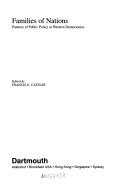
ISBN: 1855213451 Year: 1993 Publisher: Aldershot Dartmouth
Abstract | Keywords | Export | Availability | Bookmark
 Loading...
Loading...Choose an application
- Reference Manager
- EndNote
- RefWorks (Direct export to RefWorks)
Economic policy and planning (general) --- Economic sociology --- Policy sciences --- #SBIB:011.IO --- #SBIB:35H400 --- #SBIB:35H435 --- Policy-making --- Policymaking --- Public policy management --- Beleid: algemeen --- Beleidssectoren: economisch en werkgelegenheidsbeleid --- Public policy managementBeleid: algemeen
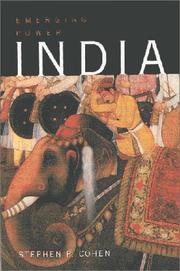
ISBN: 0815700067 0815798393 9780815798392 Year: 2001 Publisher: Washington, D.C. : Brookings Institution Press,
Abstract | Keywords | Export | Availability | Bookmark
 Loading...
Loading...Choose an application
- Reference Manager
- EndNote
- RefWorks (Direct export to RefWorks)
For years, Americans have seen India as a giant but inept state. That negative image is now obsolete. After a decade of drift and uncertainty, India is taking its expected place as one of the three major states of Asia. Its pluralist, secular democracy has allowed the rise of hitherto deprived castes and ethnic communities. Economic liberalization is gathering steam, with six percent annual growth and annual exports in excess of 30 billion. India also has a modest capacity to project military power. The country will soon have a two-carrier navy and it is developing a nuclear-armed missile capable of reaching all of Asia. This landmark book provides the first comprehensive assessment of India as a political and strategic power since India's nuclear tests, its 1999 war with Pakistan, and its breakthrough economic achievements. Stephen P. Cohen examines the domestic and international causes of India's "emergence," he discusses the way social structure and tradition shape Delhi's perceptions of the world, and he explores India's relations with neighboring Pakistan and China, as well as the United States. Cohen argues that American policy needs to be adjusted to cope with a rising India--and that a relationship well short of alliance, but far more intimate than in the past, is appropriate for both countries.
Public Policy / Economic Policy --- International relations. Foreign policy --- Internal politics --- India --- Foreign relations --- Economic conditions --- Politics and government
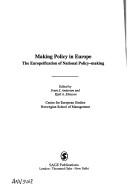
ISBN: 0803989709 9780803989702 0803989695 Year: 1993 Publisher: London Thousand Oaks, Calif. New Delhi : Sage Publications,
Abstract | Keywords | Export | Availability | Bookmark
 Loading...
Loading...Choose an application
- Reference Manager
- EndNote
- RefWorks (Direct export to RefWorks)
Public policy managementEuropese Gemeenschappen--EC --- -#A9404A --- Policy sciences --- Political planning --- 341.17 EC --- #A9404A --- Policy-making --- Policymaking --- Public policy management --- Planning in politics --- Public policy --- Planning --- Politics, Practical --- Public administration --- 341.17 EC Europese Gemeenschappen--EC --- Europese Gemeenschappen--EC --- Policy sciences. --- Communauté européenne --- Monnaie unique européenne --- Décision politique --- Politique publique --- Institutions européennes --- Pays de l'Union européenne --- Influence --- Politique et gouvernement --- 1990-....
Book
ISBN: 9780199759477 9780199759484 Year: 2013 Publisher: Oxford Oxford University Press
Abstract | Keywords | Export | Availability | Bookmark
 Loading...
Loading...Choose an application
- Reference Manager
- EndNote
- RefWorks (Direct export to RefWorks)
The diffusion and rapid evolution of new communication technologies has completely reshaped media and politics. But who are the new power players? Written by a leading scholar in the field, The Hybrid Media System is a sweeping and compelling new theory of how political communication now works. The new media system is increasingly defined by organizations, groups, and individuals who are best able to blend old and new within what Andrew Chadwick terms a hybrid system. Those who are best able to create, tap, and steer information to suit their goals are, in turn, able to modify, enable, and disable the power of others between a range of older and newer media. Chadwick looks at news making in all of its contemporary "professional" and "amateur" forms, from parties and election campaigns, to activist movements, and government communication. He weaves in compelling ethnographic material from American presidential campaigns to WikiLeaks, and from live prime ministerial debates to hotly-contested political scandals. The end result of this wide-ranging book is a map of the emerging balance of power between older and newer media technologies, genres, norms, behaviors, and organizational forms. Chadwick argues that hybrid thinking rejects simple dichotomies, and he reveals how older and newer media logics in the fields of media and politics blend, overlap, intermesh, and coevolve. Political communication has entered a new era. This book reveals how the clash of older and newer media logics is causing chaos and disintegration but also surprising new patterns of order and integration.
Mass communications --- Political sociology --- Communication in politics. --- Mass media --- Internet in political campaigns. --- Communication politique --- Médias --- Internet dans les campagnes électorales --- Political aspects. --- Aspect politique --- Communication en politique --- Médias et politique --- Political science --- BUSINESS & ECONOMICS --- Social science --- Public Policy --- General --- Industries --- Media & Communications Industries --- Popular Culture --- Social sciencePolitical aspects. --- #SBIB:309H270 --- POLITICAL SCIENCE / Public Policy / General --- BUSINESS & ECONOMICS / Industries / Media & Communications Industries --- SOCIAL SCIENCE / Popular Culture --- Political campaigns --- Communication in politics --- Political communication --- Politieke communicatie: algemene werken --- General. --- Media & Communications Industries. --- Popular Culture. --- Business & economics --- Public policy --- Media & communications industries. --- Popular culture. --- Médias --- Internet dans les campagnes électorales --- Communication en politique. --- Médias et politique. --- Internet dans les campagnes électorales. --- Internet in political campaigns --- Political aspects --- Médias et politique. --- Internet dans les campagnes électorales.
Book
ISBN: 286645619X Year: 2006 Publisher: Paris : Le Félin,
Abstract | Keywords | Export | Availability | Bookmark
 Loading...
Loading...Choose an application
- Reference Manager
- EndNote
- RefWorks (Direct export to RefWorks)
Research institutes --- Pressure groups --- Centres de recherche --- Groupes de pression --- Geopolitics. --- Political planning --- Policy sciences --- Political aspects --- Policy sciencesPolitical aspects --- BPB0607 --- AA / International- internationaal --- FR / France - Frankrijk --- US / United States of America - USA - Verenigde Staten - Etats Unis --- 323.5 --- Pressiegroepen. Lobbying. --- Geopolitics --- Institutes, Research --- Research centers --- Think tanks --- Universities and colleges --- Learned institutions and societies --- Planning in politics --- Public policy --- Planning --- Politics, Practical --- Public administration --- Policy-making --- Policymaking --- Public policy management --- World politics --- Pressiegroepen. Lobbying --- Science politique --- Conseillers du gouvernement --- Expertises --- Clubs de réflexion --- Conseillers politiques --- Recherche --- Aspect politique
Book
ISBN: 9789004230415 Year: 2013 Publisher: Leiden : Martinus Nijhoff Publishers,
Abstract | Keywords | Export | Availability | Bookmark
 Loading...
Loading...Choose an application
- Reference Manager
- EndNote
- RefWorks (Direct export to RefWorks)
Conflict of laws --- Arab Spring, 2010 --- -International law. --- Democracy. --- Democratization --- Revolutions --- Public policy --- History --- Arab countries --- Politics and government --- RevolutionsPublic policy --- HistoryArab countriesPolitics and government --- Printemps arabe (2010-....) --- Droit international --- Démocratie --- Transition démocratique --- Révolutions --- Pays arabes --- 1990-.... --- Politique et gouvernement --- Démocratie --- Transition démocratique --- Révolutions
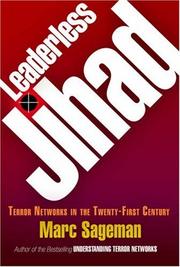
ISBN: 9780812240658 0812240650 0812206789 1283891069 Year: 2008 Publisher: Philadelphia, PA : University of Pennsylvania Press,
Abstract | Keywords | Export | Availability | Bookmark
 Loading...
Loading...Choose an application
- Reference Manager
- EndNote
- RefWorks (Direct export to RefWorks)
In the post-September 11 world, Al Qaeda is no longer the central organizing force that aids or authorizes terrorist attacks or recruits terrorists. It is now more a source of inspiration for terrorist acts carried out by independent local groups that have branded themselves with the Al Qaeda name. Building on his previous groundbreaking work on the Al Qaeda network, forensic psychiatrist Marc Sageman has greatly expanded his research to explain how Islamic terrorism emerges and operates in the twenty-first century.In Leaderless Jihad, Sageman rejects the views that place responsibility for terrorism on society or a flawed, predisposed individual. Instead, he argues, the individual, outside influence, and group dynamics come together in a four-step process through which Muslim youth become radicalized. First, traumatic events either experienced personally or learned about indirectly spark moral outrage. Individuals interpret this outrage through a specific ideology, more felt and understood than based on doctrine. Usually in a chat room or other Internet-based venues, adherents share this moral outrage, which resonates with the personal experiences of others. The outrage is acted on by a group, either online or offline.Leaderless Jihad offers a ray of hope. Drawing on historical analogies, Sageman argues that the zeal of jihadism is self-terminating; eventually its followers will turn away from violence as a means of expressing their discontent. The book concludes with Sageman's recommendations for the application of his research to counterterrorism law enforcement efforts.
Terrorists --- Terrorism. --- Jihad. --- Terroristes --- Terrorisme --- Jihad --- Social networks. --- Réseaux sociaux --- Terrorism --- Social networks --- TerroristsSocial networks. --- Jihād --- Réseaux sociaux --- Criminals --- Acts of terrorism --- Attacks, Terrorist --- Global terrorism --- International terrorism --- Political terrorism --- Terror attacks --- Terrorist acts --- Terrorist attacks --- World terrorism --- Direct action --- Insurgency --- Political crimes and offenses --- Subversive activities --- Political violence --- Terror --- Holy war (Islam) --- Islamic holy war --- Jahad --- Jehad --- Muslim holy war --- War (Islamic law) --- Terrorists - Social networks --- African Studies. --- Asian Studies. --- Middle Eastern Studies. --- Political Science. --- Public Policy.
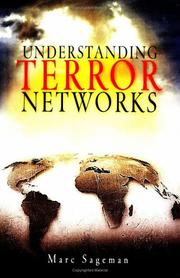
ISBN: 0812238087 0812206797 1283897288 9780812238082 9781283897280 9780812206791 Year: 2004 Publisher: Philadelphia : University of Pennsylvania Press,
Abstract | Keywords | Export | Availability | Bookmark
 Loading...
Loading...Choose an application
- Reference Manager
- EndNote
- RefWorks (Direct export to RefWorks)
For decades, a new type of terrorism has been quietly gathering ranks in the world. America's ability to remain oblivious to these new movements ended on September 11, 2001. The Islamist fanatics in the global Salafi jihad (the violent, revivalist social movement of which al Qaeda is a part) target the West, but their operations mercilessly slaughter thousands of people of all races and religions throughout the world. Marc Sageman challenges conventional wisdom about terrorism, observing that the key to mounting an effective defense against future attacks is a thorough understanding of the networks that allow these new terrorists to proliferate. Based on intensive study of biographical data on 172 participants in the jihad, Understanding Terror Networks gives us the first social explanation of the global wave of activity. Sageman traces its roots in Egypt, gestation in Afghanistan during the Soviet-Afghan war, exile in the Sudan, and growth of branches worldwide, including detailed accounts of life within the Hamburg and Montreal cells that planned attacks on the United States. U.S. government strategies to combat the jihad are based on the traditional reasons an individual was thought to turn to terrorism: poverty, trauma, madness, and ignorance. Sageman refutes all these notions, showing that, for the vast majority of the mujahedin, social bonds predated ideological commitment, and it was these social networks that inspired alienated young Muslims to join the jihad. These men, isolated from the rest of society, were transformed into fanatics yearning for martyrdom and eager to kill. The tight bonds of family and friendship, paradoxically enhanced by the tenuous links between the cell groups (making it difficult for authorities to trace connections), contributed to the jihad movement's flexibility and longevity. And although Sageman's systematic analysis highlights the crucial role the networks played in the terrorists' success, he states unequivocally that the level of commitment and choice to embrace violence were entirely their own. Understanding Terror Networks combines Sageman's scrutiny of sources, personal acquaintance with Islamic fundamentalists, deep appreciation of history, and effective application of network theory, modeling, and forensic psychology. Sageman's unique research allows him to go beyond available academic studies, which are light on facts, and journalistic narratives, which are devoid of theory. The result is a profound contribution to our understanding of the perpetrators of 9/11 that has practical implications for the war on terror.
International movements --- Islam --- Polemology --- Terrorists --- Terrorism --- Jihad --- Terroristes --- Terrorisme --- Social networks --- Réseaux sociaux --- JihadSocial networks --- Jihād --- Réseaux sociaux --- Jihad. --- Terrorism. --- Social networks. --- Criminals --- Acts of terrorism --- Attacks, Terrorist --- Global terrorism --- International terrorism --- Political terrorism --- Terror attacks --- Terrorist acts --- Terrorist attacks --- World terrorism --- Direct action --- Insurgency --- Political crimes and offenses --- Subversive activities --- Political violence --- Terror --- Holy war (Islam) --- Islamic holy war --- Jahad --- Jehad --- Muslim holy war --- War (Islamic law) --- Terrorists - Social networks --- African Studies. --- Anthropology. --- Asian Studies. --- Folklore. --- Linguistics. --- Middle Eastern Studies. --- Political Science. --- Psychology. --- Public Policy.
Book
ISBN: 9780691159386 0691170878 9780691170879 0691159386 1306168228 1400848679 Year: 2014 Publisher: Princeton (N.J.) Princeton University Press
Abstract | Keywords | Export | Availability | Bookmark
 Loading...
Loading...Choose an application
- Reference Manager
- EndNote
- RefWorks (Direct export to RefWorks)
"Modern warfare is almost always multilateral to one degree or another, requiring countries to cooperate as allies or coalition partners. Yet as the war in Afghanistan has made abundantly clear, multilateral cooperation is neither straightforward nor guaranteed. Countries differ significantly in what they are willing to do and how and where they are willing to do it. Some refuse to participate in dangerous or offensive missions. Others change tactical objectives with each new commander. Some countries defer to their commanders while others hold them to strict account. NATO in Afghanistan explores how government structures and party politics in NATO countries shape how battles are waged in the field. Drawing on more than 250 interviews with senior officials from around the world, David Auerswald and Stephen Saideman find that domestic constraints in presidential and single-party parliamentary systems--in countries such as the United States and Britain respectively--differ from those in countries with coalition governments, such as Germany and the Netherlands. As a result, different countries craft different guidelines for their forces overseas, most notably in the form of military caveats, the often-controversial limits placed on deployed troops. Providing critical insights into the realities of alliance and coalition warfare, NATO in Afghanistan also looks at non-NATO partners such as Australia, and assesses NATO's performance in the 2011 Libyan campaign to show how these domestic political dynamics are by no means unique to Afghanistan."--Publishers.
#SBIB:327.5H21 --- #SBIB:327.6H01 --- #SBIB:327.7H32 --- Vrede – oorlog, oorlogssituaties --- Internationale en diplomatieke relaties: specifieke conflicten --- Bondgenootschappen: NAVO / NATO --- Afghanistan --- History, Military --- #SBIB:327.7H32Vrede – oorlog, oorlogssituaties --- Bondgenootschappen: NAVO / NATOAfghanistanHistory, Military --- Afghan war, 2001. --- International Security Assistance Force (Afghanistan). --- North Atlantic Treaty Organization -- Afghanistan. --- North Atlantic Treaty Organization -- History. --- Afghan War, 2001 --- -International Security Assistance Force (Afghanistan) --- Regions & Countries - Asia & the Middle East --- History & Archaeology --- South Asia --- Operation Enduring Freedom, 2001 --- -War on Terrorism, 2001-2009 --- North Atlantic Treaty Organization --- North Atlantic treaty organisation --- NAVO --- OTAN --- NATO --- HISTORY / Military / General. --- POLITICAL SCIENCE / Public Policy / General. --- POLITICAL SCIENCE / International Relations / Diplomacy. --- International Security Assistance Force (Afghanistan) --- -North Atlantic Treaty Organization --- -Operation Enduring Freedom, 2001 --- ISAF --- North Atlantic Treaty Organization. --- Kumak aw Hamkārī (Afghanistan) --- -Afghan War, 2001 --- Afghanistan. --- Australia. --- British-style politics. --- Canada. --- Denmark. --- Dutch government. --- France. --- Germany. --- Great Britain. --- International Security Assistance Force. --- Jacques Chirac. --- Libya. --- NATO countries. --- NATO effort. --- NATO institutions. --- NATO intervention. --- NATO interventions. --- NATO membership. --- NATO. --- Netherlands. --- New Zealand. --- Nicolas Sarkozy. --- Operation Enduring Freedom. --- Poland. --- United States. --- agent selection incentives. --- alliance actions. --- alliance warfare. --- caveats. --- civilЭilitary relations. --- coalition governments. --- coalition warfare. --- coalitions. --- decision makers. --- decision making. --- decision units. --- defense spending. --- domestic consequences. --- domestic political institutions. --- domestic politics. --- forum shopping. --- incentives. --- intrusive oversight. --- military behavior. --- military decisions. --- military interventions. --- minority government. --- multilateral contingents. --- multilateral efforts. --- multilateral forum shopping. --- multilateral military effort. --- multilateral military operations. --- multilateralism. --- national commands. --- officer selection. --- parliamentary coalition behavior. --- parliamentary government. --- parliamentary governments. --- political coalition. --- political cultures. --- political ideology. --- prime ministers. --- principal-agency theory. --- principal-agent relations. --- red cards. --- restrictions. --- unilateralism. --- Afghan War, 2001-2021
| Listing 1 - 10 of 10 |
Sort by
|

 Search
Search Feedback
Feedback About UniCat
About UniCat  Help
Help News
News